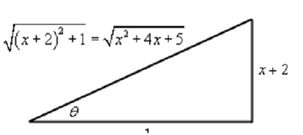Evaluate the following integral.
∫√(x2+4x+5) dx
Solution:
Remind from the Trig Substitution section that to do a trig substitution here we first required to complete the square on the quadratic. This provides,
X2+4x+5 = x2+4x+4-4+5=(x+2)2+1
After completing the square the integral becomes like this:
∫√(x2 + 4x +5) dx
= ∫ √ ((x+2)2 1dx)
Upon doing this we can recognize the trig substitution that we require. Here it is,
x + 2 = tan θ
x= tan θ -2
dx = sec2 θdθ
√((x + 2)2 +1)
= √ tan2 θ+1
=√ sec2 θ
=|sec θ |
= sec θ
Recall that as we are doing an indefinite integral we be able to drop the absolute value bars. By using this substitution the integral becomes,

∫ √x2 + 4x + 5 dx = ∫ sec3 θ d θ
= ½ (secθ tanθ + ln |secθ + tan θ|) + c
We can end the integral out along with the following right triangle.
tanθ = (x+2/1)
secθ = √(x2 + 4x +5/1)
= √ (x2+4x+5)

∫ √(x2+4x+5) dx = ½ ((x+2)√x2+4x+5+1n|x+2+√x2+4x+5|) + c
Thus, by completing the square we were capable to take an integral that had a general quadratic in it and transform it into a form that permitted us to make use of a known integration technique.